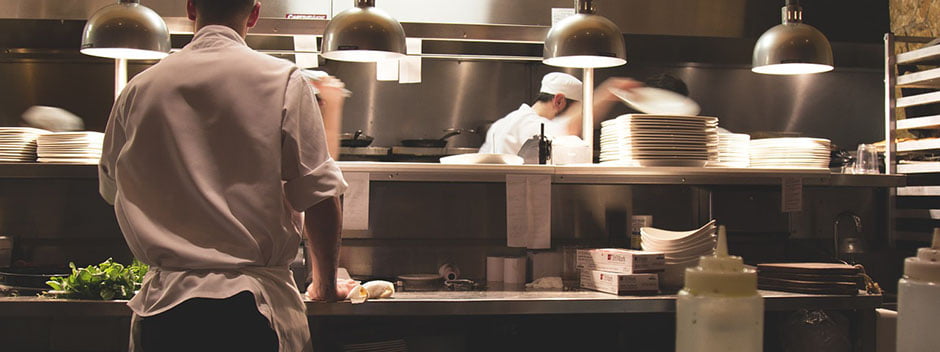How to Clean Stainless Steel Splashbacks and Countertops

An invention of the vain 40s, stainless steel surfaces have stubbornly stuck around ever since. There is a good reason for that – unlike its wooden and laminate counterparts, stainless steel has a non-porous surface that doesn’t give microorganisms convenient cracks to hide in. This, along with the tough protective film on top that sports an exceptional resistance to corrosion and rust, has made stainless steel the go-to choice for almost every professional kitchen in existence.
However, this film can easily become damaged if you use a steel pad or a wire brush for cleaning. If left to linger, puddles of hard water can also compromise the steel surface, as well as most household cleaners as they often contain chloride. Thus, knowing how to clean your stainless splashbacks and countertops properly is crucial to preserving your investment for decades on end. Below, the specialists from Star Domestic Cleaners have listed several useful cleaning methods for both steel splashbacks and countertops.
Before You Begin, Here Is a List of the Things You’ll Need
Safety always comes first and cleaning of stainless steel makes no exception. Consider stocking up on soft sponges and microfibre (or paper) towels to ensure that your surfaces will remain unscathed during the all the wiping, scrubbing, and polishing. Other things you will need include:
- Plain boiled water;
- Baking soda and liquid dish soap;
- Diluted vinegar (white or apple cider);
- Stainless steel cleaner;
- Polishing paste or spray cleaner.
The Big Four of Stainless Steel Countertop Cleaning
You probably have some of the solutions below near you, so you have no excuse of having dirty countertops and splashbacks.
1. Harness the power of boiled water
Boiled water may not be the first thing to come to your mind when you think of how to clean your stainless steel countertop. However, this simple method is more than capable of dissolving all common stains around the kitchen. Start by boiling water using a kettle with a spout. Once you hear the familiar sizzling sound, turn the stove off and cover the soiled surface with a paper towel.
Wet the towel with boiling water (don’t go overboard, you don’t want to drench the thing) and leave it steaming for about 10 minutes. Once the towel has cooled down, use it to wipe the surface in the direction of the grain. With enough scrubbing, this should take care of the pesky stains. If that is not the case, feel free to try out the second method on our list.
2. Baking soda is useful for more than just cooking
The magical properties of sodium bicarbonate, or baking soda, are well known to almost any homeowner. What they may not suspect, however, is that baking soda and liquid dish soap make for a great cleaning paste. Once you mix the two substances together, get a microfibre cloth and gently rub the sauce splashes in the direction of the grain. Then, all you have to do is give your stainless steel surfaces a really good rinse and towel them dry. As easy as slicing a cake.
3. Facing stubborn stains? Use vinegar!
Have the stains survived against all odds? Don’t get disheartened and purchase either white or apple cider vinegar from your nearest store. Containing about 5% acetic acid and 95% water, this gift from the gods is friendly to the environment (biodegradable) and extra hostile towards the blemishes on your kitchen counter. And here is how you can use it to your advantage.
Mix some vinegar and water in a 50/50 solution. Then, pour the mixture onto the stained surface and make a cup of coffee (you’ll need to stick around for a couple of minutes). Then, carefully swab up the small puddle and rub it with a soft cloth going in the direction of – you guessed it – the grain. Then, do the same as the above, i.e. thoroughly rinsing and drying your countertops. Here you can check out other 30 uses of vinegar for cleaning purposes.
4. Get a proper stainless steel cleaner
If none of the above works, then you have to call in the heavy artillery. Pay a few extra quid for a stainless steel cleaner with a good powder formula, otherwise you risk scratching the surface. Always make sure to follow the directions on the bottle and, as always, rinse and dry the countertops thoroughly once you’re done. This will help you avoid any potential discolouration. An alternative is to book our regular home cleaning service or professional one-off deep clean.
In case you’re about to move out of a rental, resolve to our specialised end of tenancy cleaning professionals and guarantee your full security deposit refund. Check the cleaning prices at Start Domestic Cleaners for more details and also the combo deals and special discounts we offer.
How to Clean a Stainless Steel Splashback
While achieving the perfect polish on a splashback isn’t really all that difficult, you really need to be very careful with your choice of products. For instance, you should never use silver dip polishes, as they can quickly corrode your splashback (this, by the way, goes for all stainless steel surfaces, not just splashbacks).
Instead, we recommend using spray cleaners that contain silicone oil. These are very good at removing grime, smudges or sticky fingerprints without the risk of damage.
There are also many types of polishing pastes on the market that you can safely use to clean your splashbacks. When applied, they will create a really thin wax layer that will make your cleaning duties easier. Note, however, that both pastes and sprays are suitable for decorative surfaces only and SHOULD NOT be used on stainless countertops, pans, and other surfaces where food is prepared. To polish those, refer to the Holy Quaternity of countertop cleaning mentioned above.


